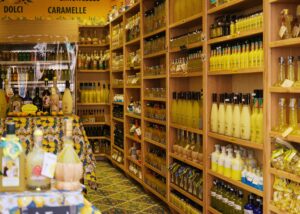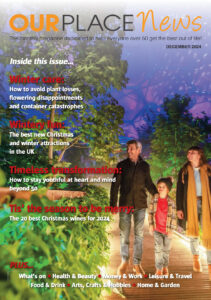
The liqueur has gone from being an occasional digestif, served in shot form, to a ubiquitous spritz popular in bars and restaurants from Adelaide to Athens. What’s behind the overnight rise of a decades-old drink?
When I was in northern Italy this month, I spotted the same sunshine-yellow drink wherever I went. Limoncello spritz – sweet-sharp lemon-flavoured liqueur, mixed with prosecco and soda water and served over ice – was on every menu. The leaves were starting to turn and there was a chill in the air, but after a couple of these summery spritzes, I could imagine myself on the Amalfi coast in August.
Until this year, I had seen limoncello served only as a complimentary shot after dinner, usually at an Italian restaurant in the UK. I always necked it – who turns down free booze? – but it never seemed exactly aspirational.
Now, in the space of a few months, I have sampled it in spritz form not just in its homeland, but also in Greece, at a wedding; in Germany, on a work trip; and in London, at a party. Why is limoncello suddenly ubiquitous? And how has it swerved from dull digestif to alluring aperitif?
It is partly down to the unstoppable rise of the Aperol spritz, one of the marketing phenomena of the past decade. Bars worldwide are pushing a variety of spritzes to find the next big thing. “People love to order a limoncello spritz as a refreshing, less bitter alternative to an Aperol or Campari spritz,” says Marica Tonucci, the operational beverage manager for the Big Mamma group of Italian restaurants in Europe.
And she isn’t just talking about customers at Big Mamma’s Milan branch. She says limoncello has become popular from London to Lille, Berlin to Brussels, but “our clients in Spain love it the most. At our restaurants in Madrid, the limoncello spritz made with a homemade mint syrup is very popular.”
Travis Toyne, the commercial director of the Chilled Pubs group in the East Midlands, agrees that lemon is an “easy” flavour, unlike, say, Campari, which isn’t everyone’s cup of tea. “I don’t think there are many people who don’t like lemon,” he says. Also, limoncello isn’t too strong, he adds. Well, yes – compared with gin, which is at least 37.5% ABV; limoncello is usually between 26% and 28%. But when mixed with prosecco, it still packs a punch – and if you are used to drinking Aperol, which is just 11%, limoncello spritz can catch you unawares. “It absolutely knocks your head off after two or three,” Toyne admits. You have been warned…
Thanks largely to the spritz, Italian limoncello producers are enjoying big increases in global sales. The Spirits Business reported that, a decade ago, more than two out of every three bottles of limoncello were drunk in Italy; last year, 50% were exported. According to European Food Agency News, Pallini limoncello, the bestselling brand, has grown by 66% in the past four years, while the sector as a whole grew 31% between 2019 and 2023. Germany and the UK are the fastest-growing markets.
In the UK, limoncello spritz was added to the menu at Wetherspoon’s pubs last month, a sure sign that the drink has gone mainstream. Steven Roennfeldt, who is based in Adelaide and is the author of Steve the Bartender’s Cocktail Guide, says it has been growing in popularity in Australia, too. “It matches so well with our hot summers and quenches your thirst,” he says. “Aperol spritz was popular for so long and limoncello spritz is the next evolution.”
The origins of limoncello are as hazy as the liqueur itself, but it is believed to have been first produced around 1900 in Naples, on the Amalfi coast (limoncello spritz is also known as an Amalfi spritz) and in Sicily. Sunshine and sweetness, lemons and la dolce vita – this association with southern Italy is surely another reason for limoncello’s success.
Traditionally, it is made by steeping the zest of sorrento or sfusato lemons in a neutral spirit, then mixing it with sugar syrup. Limoncello made this way, in these regions, may have a PGI (protected geographical indication) stamp. One such brand, Villa Massa from Sorrento, this month announced a €2m (£1.7m) investment to double production. It is already the biggest-selling limoncello in Spain, Portugal and the Netherlands and plans to expand into the US and Latin America.
But limoncello is not a PDO (protected designation of origin), like champagne, which can be made only in the Champagne region of France. Producers anywhere in the world can make a lemony liqueur and call it limoncello – and increasing numbers do, especially in California, Australia and New Zealand. Roennfeldt co-owns an Adelaide gin distillery, Threefold, that has branched out into limoncello; it is now one of its top-selling products. “Lots of Australian gin distilleries are doing really well with limoncello,” he says. “Ours incorporates native botanicals and uses limes as well as lemons.” He suggests adding a squeeze of fresh lemon juice and a pinch of salt to your spritz. “Salt really subdues the bitterness and increases the fruitiness,” he says.
Limoncello is being made by distilleries in the UK, too. Sam Evans, the head of sales at the Shakespeare Distillery in Stratford-upon-Avon, says the company first made a limited-edition batch of limoncello in 2021. It sold out almost immediately and the drink is now part of the distillery’s core range. “We have been blown away by the response. It has become a feature on many local bars’ and restaurants’ menus,” he says. Again, it is not simply a copy of Italian limoncello. “When people think about limoncello, they often think back to a holiday in Italy – having a sweet drink after dinner, sitting in the sun. Something about our British summers means that sweet style of limoncello doesn’t go down the same. Our limoncello is not overly sweetened; we allow there to be a sharpness.”
The spritz is not the only new way to serve limoncello. In Italy, I saw it being used to give a twist to classic cocktails. The Moscow mule (vodka, ginger beer and lime) became the Sorrento mule (gin, limoncello, ginger beer and lemon), while the negroni (Campari, sweet vermouth and gin) was turned into a negroni d’Amalfi by swapping the gin for limoncello. I swear by a classic negroni, but I had to admit this zingy version really worked.
Lakes Limoncello, which has made limoncello in Keswick, Cumbria, since 2021, has recently launched a limoncello sour that just needs egg whites or aquafaba to be added to make an instant cocktail. Last month, it had a licence approved for a bar that will serve cocktails and run tastings, talks and limoncello-making workshops.
Chilled Pubs has also embraced limoncello as a cocktail ingredient. As well as the spritz, its seven pubs in Derbyshire, Staffordshire and Nottinghamshire serve cocktails such as the lemon meringue, the Como crush, the twister and the bathtub, all showcasing limoncello. This makes sound business sense. “Limoncello spritz is a summer drink, but in cocktails, limoncello works year-round,” says Troyne. The pubs are releasing three limoncello-flavoured Christmas cocktails on 1 December.
Waitrose is also hoping to convince customers that limoncello is for life – and especially for Christmas. It is a central flavour in its new festive food range, which includes a limoncello fizz panettone, limoncello stollen bites and white stilton with limoncello. Lizzie Haywood, the supermarket’s innovations manager, says searches on Waitrose.com for limoncello have risen by 125% in the last 90 days. “The sweet and tangy taste of limoncello offers another twist on the citrus flavours that are loved by customers at Christmas,” she adds.
Once, that impulse-purchase bottle of limoncello would have gathered dust in the cupboard while the holiday memories faded. Now, it may be worth buying two.
(Article source: The Guardian)

